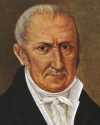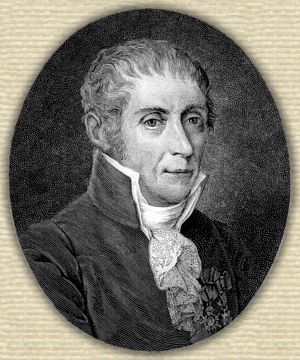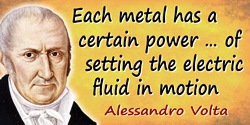 (source)
(source)
|
Count Alessandro Giuseppe Antonio Anastasio Volta
(18 Feb 1745 - 5 Mar 1827)
Italian physicist who invented the first battery, able to supply a sustained current of electricity.
|
SKETCH OF ALESSANDRO VOLTA.
from Popular Science (1892)
[p.117] VOLTA’S title to be remembered rests chiefly upon his application of the discovery of the production of electricity by contact, which has been fruitful and continues to be fruitful of results of the greatest importance in the progress of research in the domains of physical forces and of the constitution of matter, and is one of the most potent instruments in the hands of students for enlarging the boundaries of their knowledge of the material world.

Alessandro Volta was born at Como, Italy, February 19,1745, and died in the same place March 5, 1827. He began his studies in the public school of his native town, where he distinguished himself among his fellow-pupils by his capability and his assiduity at work. A passage in his first scientific paper shows that when he was eighteen years old he had been engaged in a correspondence with the Abbé Nollet on subjects relating to electricity. At nineteen years of age he composed a poem, in Latin, which has never been published, in which some of the more important discoveries of the time were described. In 1774 he was appointed to the chair of Physics in the Royal School at Como, for which his first two scientific papers—on the Attractive Force of the Electric Fire, and on the Method of constructing the New Electrical Machine—seem to have been among his strongest recommendations. He went out of Italy for the first time in 1777, to make a visit of several weeks in Switzerland, where he met Haller at Berne, Voltaire at Femey, and Benjamin de Saussure at Geneva. The story of this excursion was related in a book* which was published at Milan in 1827. In 1779 Volta was made a professor in the University of Pavia, where his instructions were attended by throngs of interested youths from all countries, proud to be his pupils, and where he continued till 1819, when he retired to spend the rest of his days in his native town. In 1782 he made what appears to have been the longest journey of his life, in company with the surgeon Scarpa, and visited the capitals of Germany, Holland, England, [p.118] and France, making the acquaintance of the most distinguished men of science in those countries. Volta’s first scientific paper, on the Attractive Force of the Electric Fire (De Vi attractiva Ignis electrici), which was addressed in 1769 to P. Beccaria, is described by M. Biot as giving only an imperfect explanation of electric phenomena, and as illustrating the characteristic trait of his mind, which led him rather to sure deductions from facts which he could experimentally follow out than to the formation of sound general theories. That part of the paper in which he showed the application of his theory to the generation of electricity is mentioned by Prof. Arthur Schuster as being of historical importance, because in it can be traced the germ of many future discoveries. He supposed that all bodies in the natural state contain electricity in such proportions that they are in electrical equilibrium, and that this was shown in the experimental results obtained by rubbing one metal with another. But when bodies are brought into close contact, as in friction, he considered that the attractions of electricity and matter might alter, according to Boscovich’s theory that attraction and repulsion alternate at short distances, and that a new equilibrium would establish itself. He expressed a belief that a disturbance of electrical equilibrium takes place during the progress of chemical action, in which the particles of matter change their position; attributed the want of proof of the fact to experimental difficulties ; and hoped that he would succeed in obtaining evidence of it; and he thought that atmospheric electricity might be accounted for in accordance with these views.
In his second paper he attempted to explain electrical insulation by the supposition of a repulsion between the insulating matter and electricity. His experiments, made in 1775, on the insulating property which wood acquires when impregnated with oil, led to the construction of the electrophorus, an apparatus which acts as a permanent and inexhaustible source whence electricity can be drawn at will. A letter of Volta’s to Priestley is preserved, dated June 10, 1775, announcing the construction of this instrument, and asking the English chemist, as the historian of electricity, how far the discovery was new. Volta’s experiments on the electrostatic capacity of conductors, described in a letter to De Saussure in 1778, were in advance of anything that had been published up to that time, although Cavendish had already experimented on the subject; but Cavendish’s results were not published for a long time afterward. Volta’s ingenious efforts, pursued continuously, to improve the electrophorus, led up to the discovery of the electric condenser, the description of which, and the account of its applications to the study of electrical phenomena, were published in the Philosophical Transactions [p.119] of 1782. By means of this apparatus, according to M. Biot, the smallest quantities of electricity, emanating from a source that can reproduce them constantly as they are taken away, were fixed and accumulated in a conductive plate by virtue of the momentary attraction of electricity of a different denomination, from which they were withdrawn when it was desired to make them perceptible and to subject them to observation. During this time Volta was still trying to find signs of electricity during the processes of evaporation and boiling and changes of temperature; and he finally thought he had discovered electrical effects during the evaporation of water—in the phenomena which are now attributed to the friction of the vapor. These results suggested the closer examination of the phenomena of atmospheric electricity, concerning which—Meteorologia Elettrica—he wrote a number of letters to Lichtenberg. Two of his letters related to electrical measurements and the straw electrometer, in which the angle of divergence of two electrified straws was measured. He also, according to Prof. Schuster, constructed the first absolute electrometer, and compared his other instruments with it, so that it would be possible now to refer all his measurements to absolute units. His electrometer consisted of a balance, one pane of which was a flat round disk. Below this disk was placed a large parallel plate, conducted away to earth, while stops were arranged so that the disk could not approach nearer than within two inches of the plate. In the unelectrified state the balance was in a condition of equilibrium. When the disk was electrified, it was attracted toward the plate, but kept at its proper distance by the stops; weights were then added in the other plate of the balance until the disk was pulled away from the stops. The letters also contain discussions on the action of points and flames in discharging electricity. To Volta are further owing the invention of the electric eudiometer and of the inflammable air or hydrogen lamp. Prof. Schuster regards as worthy of mention also Volta’s investigations on gas analysis and his paper on the expansion of gases by heat. He showed the causes which had led different experimenters to inconsistent results, and established independently what is now known as the law of Charles.
Volta’s crowning discovery of the voltaic pile grew out of researches which were suggested by Galvani’s famous experiment with the frog. Galvani attributed the phenomena which he observed in the frog’s muscle to a new kind of electricity, which he called animal electricity. Volta, following up his experiments with more accurate instruments and by a more careful method, came to a different conclusion. He noticed that the convulsions of the frog’s muscle were very rarely produced when a single metal was used, and then only under conditions of extreme [p.120] irritability; but that they occurred with certainty and continued for some time when he had a circuit of two heterogeneous metals. From this he concluded that the exciting principle resided in the metals; and as this principle was evidently electric, since its transmission was interrupted by all the substances that intercept the electric current, that the mere contact of heterogeneous metals would develop a quantity of electricity which, though weak, would be competent when transmitted through the organs of the frog, completing the chain, to produce the convulsions. He demonstrated the verity of his induction by positive and direct experiments through which this weak electricity was accumulated in his condenser and made perceptible. He further found that this mode of development of electricity by simple contact was applicable, not to metallic bodies only, but to all heterogeneous bodies, although with different degrees of intensity according to their several natures; and having discovered the general principle, which had not been suspected before, he applied it to the construction of a new apparatus which was capable of producing infinitely augmented effects. In order to increase the intensity of his contact electricity, he enlarged the number of the metallic disks or plates he employed to produce it. His efforts were for some time unfruitful. Ho remarked that when he placed a disk of copper between two disks of zinc, or a disk of zinc between two disks of copper, the electrization was neutralized. He then thought to separate the disks by a conducting body, and found that by placing moistened paper between two double metallic disks the electric intensity was doubled. It was after that easy, by increasing the number of disks and separating them by moistened cloth, to obtain an electric intensity corresponding with the number of pairs. Concerning this series of experiments, he wrote in a letter to a French philosopher, M. La Metherie, which was published in the Journal de Physique in 1801: “Having found what degree of electricity I obtained with one of these metallic couples, by the aid of the condenser I use, I proceed to show that with two, three, or four couples, properly arranged—that is, all turned in the same direction and communicating with one another by as many moist layers (which are required, as I have shown, to prevent actions in the contrary direction)—we have double, triple, quadruple, etc.; so that if with a single couple we succeed in electrifying the condenser to the point of its causing the electrometer to indicate, for example, three degrees, with two couples we will get six, with three nine, and with four twelve degrees, if not exactly, nearly so.”
Although opinions may differ as to the interpretation of some of the experiments, Prof. Schuster remarks, in the Encyclopaedia Britannica, that there is not much in Volta’s writings on the [p.121] subject which could he called incorrect, even at the present day. His first communication concerning his researches on the development of electricity by contact was addressed to the Royal Society of England in 1792. In his account of the pile, addressed to Sir J. Banks, and read before the Royal Society in June, 1800, Volta described some of the experimental results obtained with it, and showed that all the effects produced were the same as those which could be obtained from electrical machines, and that therefore galvanism and electricity were identical.
Volta received the Copley medal of the Royal Society in 1791 or 1792. In 1801 he visited Paris, upon the invitation of the First Consul, and there repeated his experiments on the development of electricity by contact before a commission of the Institute. According to M. Arago’s story of the meeting, the First Consul desired to attend in person the session at which the commissioners were to present a detailed account of the grand phenomena. Hardly had their conclusions been read, when he proposed to decree a gold medal to Volta as a testimonial of the appreciation in which he was held by French men of science. Custom and the academical regulations hardly permitted compliance with this demand; but the regulations were made for ordinary conditions, and the professor from Pavia had placed himself beyond their line. The medal was voted by acclamation; and on the same day Volta was given, by order of Napoleon, the sum of two thousand francs from the state funds toward the expenses of his journey. In 1808 he was made one of the eight foreign associates designated by the Institute. He was also decorated with the crosses of the Legion of Honor and of the Iron Crown; was named a member of the Council of Lyon; and in 1810 was raised to the dignity of a senator of the kingdom of Italy, with the title of count. When, in 1804, he desired to retire from the university, the Emperor said he could not consent to such a step. “If Volta’s functions as a professor are fatiguing to him, let them be reduced. Let him, if he will, have to give only one lesson a year; but the University of Pavia would be struck to the heart on the day that I should permit so illustrious a name to disappear from the list of its members. Besides,” he added, “a good general ought to die on the field of battle.” So Volta continued to attract young men to his lectures. In 1815 the Emperor of Austria made Volta Director of the Philosophical Faculty of Padua.
Sir Humphry Davy, who visited Volta at Milan in 1814, when ho was sixty-nine years old, found him a man well advanced in age and in poor health. “His conversation was not brilliant; his views were narrow, but marked by considerable ingenuity. His manners were of perfect simplicity. He had not the air of a courtier, or even that of a man who had lived in the world. In [p.122] general, Italian men of science are without affectation in their manners, although they lack grace and dignity.” Arago draws a somewhat more favorable portrait of him, saying, “Volta was tall, and had noble and regular features like those of an ancient statue; a broad forehead, which laborious thought had deeply furrowed, a face on which were painted alike calmness of soul and a penetrating intellect. … His manners always retained traces of rustic habits contracted during his youth. Many persons recollect having seen Volta, when in Paris, going daily to the bake-shop, and afterward eating in the streets the bread he had bought there, without imagining that he was an object of remark. … Strong and quick intelligence, large and just ideas, and an affectionate and sincere character were his dominant qualities. Ambition, the thirst for gold, the spirit of rivalry, dictated none of his actions. With him the love of learning, the only passion which ho had experienced, continued free from all worldly alliance.”
A collection of Volta’s writings, drawn from the journals and periodical transactions in which they first appeared, was published at Florence in 1816, in five volumes. It is pronounced valuable by M. Biot, on account of the fidelity with which we may trace in it the succession of his ideas on the most important subjects in which he was interested during his long career.
- Science Quotes by Count Alessandro Giuseppe Antonio Anastasio Volta.
- 18 Feb - short biography, births, deaths and events on date of Volta's birth.
- Alessandro Volta - Illustration of Volta from Robert Millikan's textbook, A First Course in Physics (1906).
- Alessandro Volta - Enlarged Details of Illustration Border from Robert Millikan's textbook.
- Alessandro Volta - Monument in Pavia, Italy.
- Volta: Science and Culture in the Age of Enlightenment, by Giuliano Pancaldi. - book suggestion.
- Booklist for Alessandro Volta.





